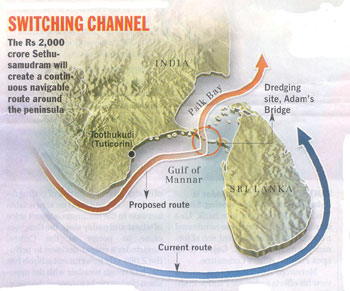By Shivani Thakur
A British commander in 1860 dreamt of a project-The Sethusamudram Canal Project. The construction of this canal was to cut short travel time between the east and west coast of India ; linking Gulf of Mannar and Palk Strait by more than
20 hours. This dream is being turned into reality but at the cost of environment. The canal to be constructed is around 260km long and 300m wide; through Adams Bridge . Currently the ships have to circumnavigate Srilanka to reach the east coast, which means
an extra day of travel and more fuel consumption. The Environment Ministry has given a go ahead. It now awaits approval of Union Cabinet.

But this project has come under scrutiny. There is a lot of opposition from eco groups and fishermen. Fishermen feel that many rare export varieties of fish will move away Adams Bridge and reduce their inadequate fishing area. The Bridge
also acts as check dam. The environment effect this re-routing would result in major changes in the biodiversity of Gulf of Mannar . The Gulf is home to endangered marine species including sea horses, pipe fish, sea cows and coral. The route will pass about
20 km away from Shingle Island and 6km from VanTivu Island , both, which are part of Gulf of Mannar Marine National Park . There is a proposal that a buffer zone of 25 km around national parks should be created. The damage to coral reefs can cause high sea
tides. Once the canal is built there would be movement of fish from Bay of Bengal to Indian Ocean , which could prove dangerous to the eco-system. Any oil spill in this region would mean the pollutants could reach the coast.
Besides the environmental impact, there are many technical as well as economic aspects being overlooked. A thorough study has to be done of the currents and changes in the ocean floor to avoid any damage to the canal by violent currents.
The canal is being compared to the Suez Canal of the east. Whereas Suez Canal was constructed by cutting land, this is being done by dredging a strait. Its economic viability is also being questioned. The canal once built would allow ships of capacity of 30,000
tonne only. They would have to slow down to navigate through the narrow canal. This would in turn mean more time wastage as well as fuel consumption. Besides, modern ships are of over 100,000 tonne capacity. Therefore the project is no longer feasible.
The economic viability to environment impact, this project to cut through a natural chain of shoals raises a lot of questions. We quote a news item, which appeared in the Hindu.
“The Rs 2000 crore project will be viable only if the Sethusamudram Ship Canal (SSC) is a free seaway. The coal / oil ships, to avoid collision, would have to pass through canal under regulated pilotage and pushed/ pulled by tugs belonging
to the SSCP. The ships passing by would be expected to pay the SSCP for using the facility. Although the official reports say that the investment of Rs 2000 crore would be recovered with 9 % interest within 25 years after which it will bring mammoth profit.
The question arises: will the saving in fuel cost be substantially greater than charge to be levied by the SSCP to enthuse ship-owners to use the canal? If the SSCP is to make profit its levy must leave a margin after meeting the cost
of amortization of capital and the annual revenue expenditure incurred on maintenance dredging and provision of the pilotage services.
If the Chennai rate is assumed, the same ship will have to pay over Rs 60 lakhs to use the Sethusamudram Canal . But the cost of fuel saved by same ship to take the shorter route will be less than Rs 7 lakh. The saving time will be less
than 36 hours because the ship cannot be towed at normal speed. Time will also be lost in embarkation /disembarkation of pilots and other inspection procedures. The saving time of a day will not justify over 8 times the cost of fuel saved.
Thus, the Sethusamudram canal will save money and the SSCP will be financially viable are mutually contradictory. It cannot be compared to Suez Canal because the 160 km long Suez Canal saves a distance of 9000 km between a European port
and any other eastern port such as Colombo, Chennai, Singapore and consequent saving in fuel cost and time is substantial enough for ships to grudgingly pay the toll charges levied by Suez Canal Authority.
-K.S.Ramakrishnan, a former Deputy Chairman of Chennai Port Trust and former Managing Director Of Poompuhar Shipping Corporation, in the Hindu Open Page dated Dec.20, 2004
( Picture: Courtesy India Today May 16, 2005 )